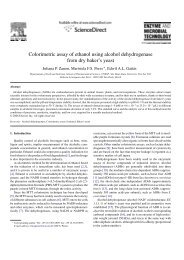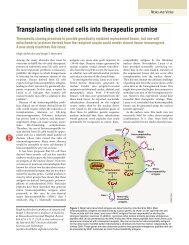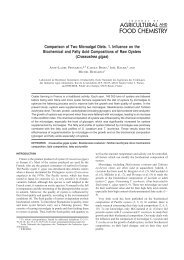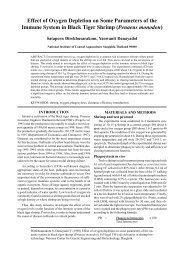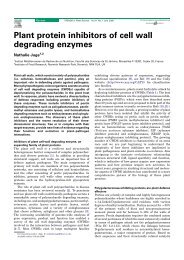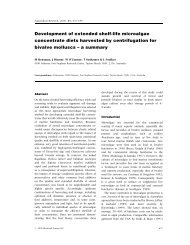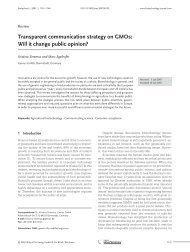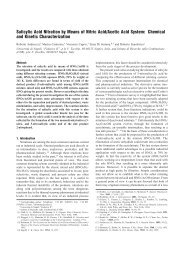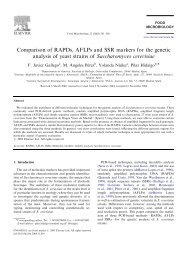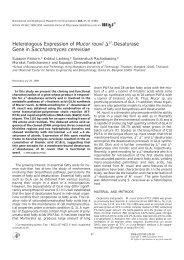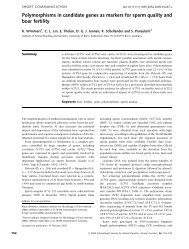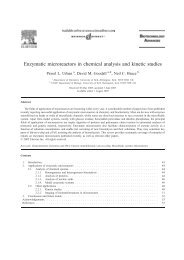Microbial production of tannase - Aseanbiotechnology.info
Microbial production of tannase - Aseanbiotechnology.info
Microbial production of tannase - Aseanbiotechnology.info
Create successful ePaper yourself
Turn your PDF publications into a flip-book with our unique Google optimized e-Paper software.
similar characteristics in terms <strong>of</strong> pH andtemperature<br />
activity andstability. When tannic acidis usedas<br />
substrate Km values <strong>of</strong> 11.25 mM and0.048 mM were<br />
obtainedwith Aspergillus and Penicillium, respectively.<br />
(Yamada, Iibuchi, & Minoda, 1968; Adachi, Watanabe,<br />
& Yamada, 1971; Libuchi, Minoda, & Yamada, 1972;<br />
Aoki, Shinke, & Nishira, 1976; Chae & Yu, 1983).<br />
Ramirez-Coronel, Viniegra-Gonzalez, Darvill, and<br />
Augur (2003) produced two <strong>tannase</strong> forms by solid<br />
state culture with molecular masses <strong>of</strong> 90 kDa and<br />
180 kDa. The <strong>tannase</strong> hadan isoelectric point <strong>of</strong> 3 8, a<br />
temperature optimum <strong>of</strong> 60–70 C anda pH optimum <strong>of</strong><br />
6 0. The substrate specificity <strong>of</strong> the <strong>tannase</strong> was<br />
determined by HPLC analysis <strong>of</strong> tannin substrates and<br />
products. The enzyme was able to remove gallic acid<br />
from both condensed and hydrolysable tannins. Internal<br />
sequences were obtainedfrom each <strong>of</strong> the gel-purified<br />
and trypsin-digested <strong>tannase</strong> forms. The peptide sequences<br />
obtainedfrom both forms were identical to<br />
sequences within a b-glucosidase from Aspergillus<br />
kawachii. The purified<strong>tannase</strong> was testedfor bglucosidase<br />
activity and was shown to hydrolyse<br />
cellobiose efficiently. However, no b-glucosidase activity<br />
was detected when the enzyme was assayed in the<br />
presence <strong>of</strong> tannic acid.<br />
The effect <strong>of</strong> metal ions on <strong>tannase</strong> activity was<br />
studied recently by Kar, Banerjee, andBhattacharyya<br />
(2003). One mM Mg +2 or Hg + activated<strong>tannase</strong><br />
activity. Ba +2 ,Ca +2 ,Zn +2 ,Hg +2 andAg + inhibited<br />
<strong>tannase</strong> activity at 1.0 mM concentration andFe +3 and<br />
Co +2 completely inhibited<strong>tannase</strong> activity. Ag + ,Ba +2 ,<br />
Zn +2 andHg +2 competitively inhibited<strong>tannase</strong> activity.<br />
Among the anions studied, 1 mM Br or S2O3 2<br />
enhanced<strong>tannase</strong> activity. Tween 40 andTween 80<br />
enhanced<strong>tannase</strong> activity whereas Tween 60 inhibited<br />
<strong>tannase</strong> activity. Sodium lauryl sulfate and Triton X-100<br />
inhibited<strong>tannase</strong> activity. Urea stimulated<strong>tannase</strong><br />
activity at a concentration <strong>of</strong> 1.5 M. Among the<br />
chelators chosen for the present study, 1 mM EDTA<br />
or 1,10-o-phenanthrolein inhibited<strong>tannase</strong> activity.<br />
Dimethyl sulphoxide and b-mercaptoethanol inhibited<br />
<strong>tannase</strong> activity at 1 mM concentration whereas soybean<br />
extract inhibited<strong>tannase</strong> activity at concentrations<br />
varying from 0.05% to 1.0% (w/v). Among the nitrogen<br />
sources selectedammonium ferrous sulfate, ammonium<br />
sulfate, ammonium nitrate andammonium chloride<br />
enhanced<strong>tannase</strong> activity at 0.1% (w/v) concentration.<br />
8. Tannase applications<br />
One <strong>of</strong> the major applications <strong>of</strong> <strong>tannase</strong> is in the<br />
manufacturing <strong>of</strong> instantaneous tea. Tannase applications<br />
in food and beverage industrial products contribute<br />
to remove the undesirable effects <strong>of</strong> tannins<br />
(Boadi & Neufeld, 2001). Other important application<br />
ARTICLE IN PRESS<br />
<strong>of</strong> <strong>tannase</strong> is the <strong>production</strong> <strong>of</strong> gallic acid and<br />
propylgallate (Kar, Banerjee, & Bhattacharyya, 2002).<br />
The former one is usedin the pharmaceutical industry<br />
for the synthesis <strong>of</strong> antibacterial drugs and in the food<br />
industry as substrate for the chemical synthesis <strong>of</strong> food<br />
preservatives such as pyrogallol andgallates. On the<br />
other hand, propylgallate is a very important food<br />
antioxidant (Sharma & Gupta, 2003). Tannase may<br />
contribute to plant cell wall degradation by cleaving<br />
some <strong>of</strong> the cross-links existing between cell wall<br />
polymers (Garcia-Conesa, Ostergaard, Kauppinen, &<br />
Williamson, 2001). Tannase can be potentially usedfor<br />
the degradation <strong>of</strong> tannins present in the effluents <strong>of</strong><br />
tanneries, which represent serious environmental problems<br />
(Van de Lagemaat & Pyle, 2001). Also, it can be<br />
usedin the preparation <strong>of</strong> animal feeding using as<br />
culture support the mycelial wastes from penicillin<br />
manufacture (Nuero & Reyes, 2002).<br />
9. Concluding remarks<br />
The use <strong>of</strong> <strong>tannase</strong> from different microbial sources<br />
may have benefits for different areas such as food,<br />
beverage, cosmetic andpharmaceutical industries as<br />
well as environmental depollution. For that, more effort<br />
is needed in order to develop more productive process<br />
for <strong>tannase</strong> <strong>production</strong>. In this sense, solid state<br />
fermentation presents more advantages that the submergedtype<br />
<strong>of</strong> culture. Improvements on <strong>tannase</strong><br />
immobilization are needed for the development <strong>of</strong><br />
cheaper process. For that, enzymatic preparations with<br />
improved catalytic characteristics must be developed.<br />
Acknowledgements<br />
C.N. Aguilar thanks CONACYT-SEP (Project:<br />
42244) andCOAH-CONACYT (COAH-2002-<br />
CO1.2565 and4652) for financial support. The present<br />
work was conducted within the framework <strong>of</strong> the ECOS<br />
program (M02A02). R. Belmares andA. Ram!ırez-<br />
Coronel are the recipients <strong>of</strong> a M.Sc. andPhD scholarships<br />
from CONACYT-Me´ xico, respectively.<br />
References<br />
Abdel-Naby, M. A., Sherif, A. A., El-Tanash, A. B., & Mankarios, A.<br />
T. (1999). Immobilization <strong>of</strong> Aspergillus oryzae <strong>tannase</strong> and<br />
properties <strong>of</strong> the immobilizedenzyme. Journal <strong>of</strong> Applied Microbiology,<br />
87(1), 108–114.<br />
Adachi, O., Watanabe, M., & Yamada, H. (1971). Physicochemical<br />
properties <strong>of</strong> the <strong>tannase</strong> from Aspergillus flavus. Agricultural and<br />
Biological Chemistry, 32, 1079–1085.<br />
Aguilar, C., Augur, C., Favela, E., & Viniegra-Gonz!alez, G. (2001a).<br />
Induction and repression patterns <strong>of</strong> fungal <strong>tannase</strong>




